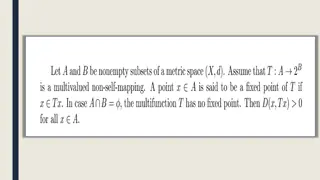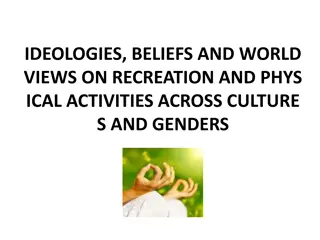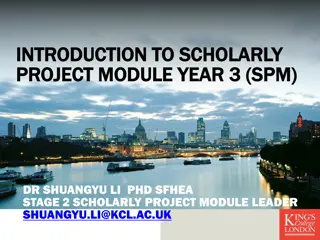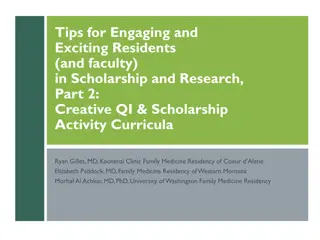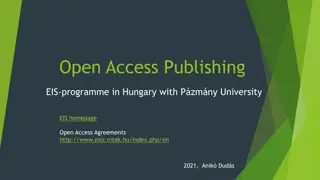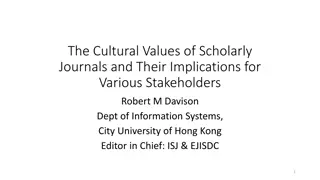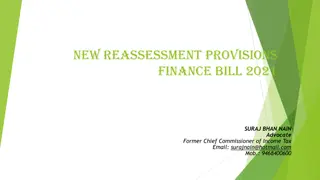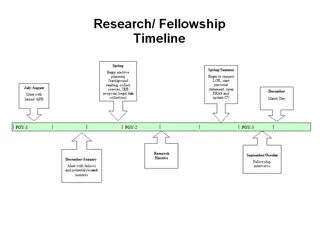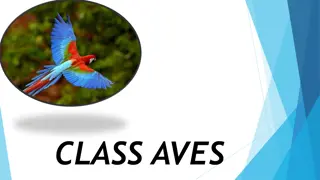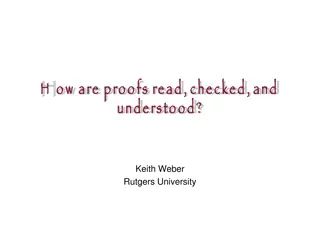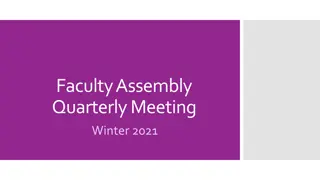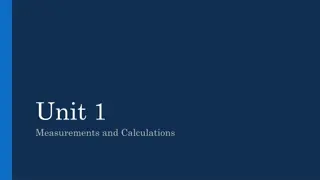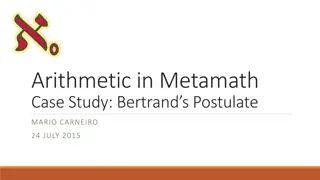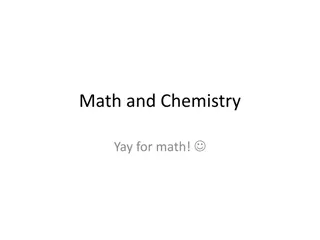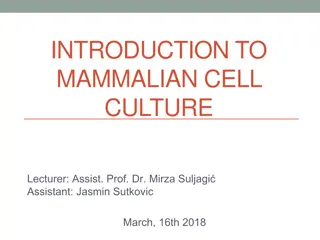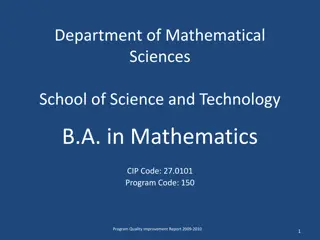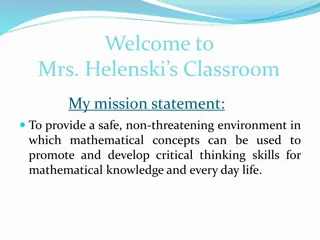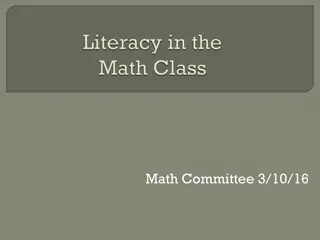Reassessing Scholarly and Sub-Scientific Mathematical Cultures
Scholarly and sub-scientific mathematical cultures are reevaluated through the works of Jens Hoyrup, focusing on the organized nature of sub-scientific knowledge. The distinction between theoretical and practical knowledge, applications to mathematical cultures, and misconceptions related to the superiority of scholarly over sub-scientific mathematics are discussed.
Download Presentation

Please find below an Image/Link to download the presentation.
The content on the website is provided AS IS for your information and personal use only. It may not be sold, licensed, or shared on other websites without obtaining consent from the author. Download presentation by click this link. If you encounter any issues during the download, it is possible that the publisher has removed the file from their server.
E N D
Presentation Transcript
Scholarly and sub-scientific mathematical cultures: a reassessment Albrecht Heeffer Max Planck Institute for History of Science, Berlin Center for History of Science, Ghent University Cultures of Mathematics IV 22-25 March 2015 New Delhi, India
Overview Hoyrup s distinction of 1990 Application to mathematical cultures Criteria and examples Contemporary distinctions
Original term H yrup, Jens (1990) Sub-Scientific Mathematics: Observations on a Pre-Modem Phenomenon , History of Science, 28:63-86. follow-up: Sub-scientific mathematics: undercurrents and missing links in the mathematical technology of the Hellenistic and Roman world , In Measure, Number and Weight, 1994, SUNY
Sub-scientific knowledge distinction applies to the organization of knowledge not just a collection of tricks and rules of thumb H yrup: In order to emphasize both the organized character of this kind of specialists knowledge going beyond the common perceptions of man and the distinct character of this organization, I have suggested the term subscientific knowledge examples of organized sub-scientific mathematical knowledge: recreational problems practical arithmetic
Misunderstandings Distinction does not imply: 1. theoretical vs. practical mathematical knowledge scientific knowledge: knowledge for the sake of knowing sub-scientific knowledge: specialist knowledge acquired and disseminated for its use 2. superiority of scholarly over sub-scientific mathematics 3. sub-scientific mathematics as a phase towards scholarly mathematics
1. Theoretical vs. practical Aristotle, Metaphysics, (981b 14 982a1) theoretical vs productive knowledge At first he who invented any art whatever that went beyond the common perceptions of man was naturally admired by men, not only because there was something useful in the inventions, but because he was thought wise and superior to the rest. But as more arts were invented, and some were directed to the necessities of life, others to recreation, the inventors of the latter were naturally always regarded as wiser than the inventors of the former, because their branches of knowledge did not aim at utility. Hence when all such inventions were already established, the sciences which do not aim at giving pleasure or at the necessities of life were discovered, [...] So [...], the theoretical kinds of knowledge [are thought] to be more the nature of Wisdom than the productive
2. No normative distinction the distinction does not imply the superiority of scholarly over sub-scientific knowledge however, scholarly traditions have been regarded superior in different cultures (Japan, Renaissance, ..) in the historiography of mathematics when sub-scientific traditions show an influence of other cultures Humanists vs. Arabic influences reception of Indian mathematics in the 19th century if not considered inferior, sub-scientific traditions have been neglected in historiography
3. Co-existence Scholarly and sub-scientific knowledge can co- exist Examples studied by H yrup: Old-Babylonian mathematics Medieval tradition Arabic mathematics
Proposal application of the distinction to mathematical cultures rather than mathematical knowledge more a sociological distinction than an epistemological one epistemological differences exist, but they also exist between scholarly cultures (East West) examples of scholarly and sub-scientific cultures in different traditions: Old-Babylonian Ancient China India Japan (Edo period) Medieval Europe
Categories of distinction 1. use of language 2. circulation of knowledge 3. social support 4. openness for foreign influences 5. systems of enculturation 6. historiography
Category 1: Language Scholarly cultures Sub-scientific cultures Learned languages Old-Babylonian: Sumerian (language for scribes) India: Sanskrit Europe, Medieval Latin tradition Vernacular Old-Babylonian: Akkadian, Eblaite India: vernaculars Europe, abbaco tradition: Italian, Catalan, Provencal
Category 2: Knowledge dissemination Scholarly cultures Sub-scientific cultures Written tradition authoritative texts commentaries Examples Old-Babylonian: scribal class India: scholastic tradition Europe: scholastic tradition quadrivium (Boethius, Euclid) Oral tradition master-apprentice relations secret treatises, notebooks Examples Old-Babylonian: surveyors India: merchant class Europe: abbaco masters treatises as a trade secret passed down family generations (the Calandri)
Category 3: Social support Scholarly cultures Official authorities: emperor, king, princes, capital supported defended against contamination Examples China: xylographs of the ten computational manuals Europe: quadrivium at the universities Sub-scientific cultures Lay culture surveyors (geometry) merchants, artisans (arithmetic and algebra) Examples Old-Babylonian: surveyors India: merchant class Europe: abbaco masters educating the merchants
Category 4: Openness Scholarly cultures Conservative, defensive reject change hostile against foreign influences Examples China: xylographs of the ten computational manuals Europe: humanists eradicating barbaric influences Sub-scientific cultures Open for foreign influence cross-cultural mathematical practice travelling through merchant routes Examples silk route recreational problems Europe: abbaco culture embracing algebra
Franois Vite In his dedication to Princess M lusine (Isagoge, 1591): Behold, the art which I present is new, but in truth so old, so spoiled and defiled by the barbarians, that I considered it necessary, in order to introduce an entirely new form into it, to think out and publish a new vocabulary, having gotten rid of all its pseudo-technical terms (pseudo-categorematis) lest it should retain its filth and continue to stink in the old way
Franois Vite New terminology for algebra: logistica speciosam (symbolic logistic): algebra zetetics: translation of a problem into a symbolic equation poristics: manipulation of the equation by the rules of algebra exegetics: interpretation of the solution of the problem latus (res): the unknown, shay quadratus (census): square of the unknown, m l antithesis (restoration): al-jabr ( ) hypobibasmo (reduction): al-ikm l ( ) parabolismo (reduction): id. Use of Diophantus
Category 5: Enculturation Scholarly cultures Sub-scientific cultures Education system supported by lay culture schools learning by doing (calculating) apprenticeship Examples Europe: abbaco schools teaching Hindu-Arabic arithmetic Official education elite system rote learning Examples Old-Babylonia: scribal schools Europe: universities
Enculturation in scholarly culture Almost 4000 years of math education Babylonian scribal schools: first organized classes for mathematics education Iraq, Nippur, House F, c.1900-1721 BC, excav. 1952 127 tablets of the school tablets deal with mathematics (18%) 7 similar excavation sites found knowledge of mathematics very important to the scribal class
Category 6: Historiography Scholarly cultures Sub-scientific cultures Dominant in the history of mathematics Ancient Greece as a model Examples Humanist myth: all valuable knowledge emerged from Ancient Greek soil Moritz Cantor History undervalued, understudied past 30 years Examples Europe: abbaco culture (studied since 1960 s) Old-Babylonian algebra: the new interpretation (1980 s)
Mathematics of sub-scientific cultures merchant arithmetic and algebra rule of three exchange of money barter partnership and partnership in time interest and discount repayment of loans alligation (of metals or liquids)
Mathematics of sub-scientific cultures Practical geometry from surveying tradition (Old-Babylonian) master builders, architects mensuration distances, surfaces, volumes gauging perspective fortification, balistics sun-dials
Mathematics of sub-scientific cultures Recreational problems riddles lack of care for reality surprise or awe effect culturally embedded often trick solution or easy recipe teaching function cross-cultural
Influences between cultures 1. Institutionalization sub-scientific knowledge is incorporated into scholarly culture examples: land administration: Old-Baylonian algebra taxation on commerce: Ancient China
Example 1: incorporating surveyors knowledge into scribal culture J. Friberg (2009) A Geometric Algorithm with Solutions to Quadratic Equations in a Sumerian Juridical Document from Ur III Umma , Cuneiform Digital Library Journal 2009, (3). YBC 3879, a juridical field division document from the Sumerian Ur III period (2100-2000 BC) the first documented appearances of metric algebra problems in a pre-Babylonian text the first documented appearance of metric algebra problems in a non-mathematical cuneiform text
YBC 3879 Field plan K1: triangle K2: triangle K3: quadrilateral K4: trapezoid K5: trapezoid K6: triangle
YBC 3879 Division of land Dividing the remaining land into 5 strips of equal area
YBC 3879 method p Given: p, f, B f: constant Find the area of the trapezoid B s f/2.s f = 2 B p s 2s
YBC 3879 method 2p Transform by scaling x 2 F b = b f s = 2 F B b = 2 2 F p b b
YBC 3879 method F and p known p b can be computed
Example 2: institutionalizing sub- scientific mathematical culture The 10 computational manuals of Chinese mathematics Officially compiled with the Tang dynasty (618-627) Xylographed in 1084, 1213 Printed in 1407, 1573, 1728, 1773, 1794
The ten computational manuals Chinese Title Translation Author Date Zhoubi suan jing Gnomonic computations ?? 100 BC-600 Jiu zhang suan shu Nine chapters ?? 200 BC-300 Haidoa suan jing Sea Island manual Liu Hui 3th cent Sun Zi suan jing Sun Zi s comp. manual Sun Zi 5th cent Wu cao suan jing Five administrative sections ?? 5th cent Xiahou Yang suan jing Xiahou Yang s manual Xiahou Yang c.350 Zhang Qiujian suanjing Zhang Qiujian s manual Zhang Qiujian 466-485 Wu jing suan shu Five classics ?? 566 Shu shu ji yi Traditional numerical proc. Zhen Luan 6-7th cent Sandeng shu Art of the three degrees Zhen Luan 6-7th cent Jigu suan jing Continuations of ancient Li Chunfeng 7th cent Zhui shu Method of Interpolation Li Chunfeng 7th cent
Need for calculation in administration Typical example: The Nine Chapters (6: J nsh ) Now there is a man carrying hulled grain, who passes through three customs posts: the outer post takes 1 in 3; the middle post takes 1 in 5; the inner post takes 1 in 7; the remaining hulled grain is 5 d u. Question: how much was he originally carrying? 1 1 1 1 1 1 1 = 5 x x x x x x x x 3 5 3 7 3 5 3
Influences between cultures 2. Merging cultures mathematics from sub-scientific culture is brought onto scholarly culture examples: India: classical period (600 1200 AD)
Example: ryabhaya Primarily astronomical treatise (dated 499) 400-600 also called The astronomical period Contents 1. astronomical constants and the sine table 2. mathematics required for computations (ga itap da) 3. division of time and rules for computing the longitudes of planets using eccentrics and ellipses 4. the armillary sphere, rules relating to problems of trigonometry and the computation of eclipses (gol dhyaya)
Sub-scientific culture: Bakhshl Manuscript Discovered in the village Bakhsh l in 1881 Sanskrit text on 70 leaves of birch bark Mostly practical and merchant arithmetic Phd by Takao Hayashi (1995) dated 7th century but contains earlier material Merchant arithmetic proportional division rule of inversion rule of false position
Influences between cultures 3. scholarly culture transcends a dominant sub- scientific culture scholarly mathematical cultures from sub- scientific culture is examples: Edo period Japan: Seki school
Jinkki (1627) by Yoshida Mitsuyoshi ( ) first important wasan book used as a textbook for merchants children at the Terakoya (private school) expanded and printed in more than 300 editions (up till the 20th century) modern English edition (Wasan Institute, 2000) 1641 edition
Jinkki (1641) Book 1, 19 chapters: numeration, units of volume, area & weight, : multiplication tables and divison, soroban excercises, practical excercises, exchange and interest Book 2, 13 chapters: commercial problems, area and volume calculation Book 3, 24 chapters: Josephus problem, distance and height calculation, geometric progressions, chinese remainder problem, square and cubic root, pi Supplement, 12 unsolved problems: quadratic, volume of a sphere, polygons, tesselation, inheritance, binomial coeficients, triangle problems
Seki school new scholarly mathematical culture Seki Takakazu ( , 1642 1708) raised within wasan culture worked as a surveyor familiar with Chinese works using the Celestial element method (higher degree algebra) translated in 1658 by Hisada Gentetsu, titled Sanp ketsugish ( ) refined by Seki (side writing method)
Sangaku San Gaku ( , mathematical tablet) placed as offerings at Shinto shrines or Buddhist temples final solution usually given only a dozen books with sangaku collections some in unpublished manuscripts most wooden tablets lost about 900 tablets extant 1800 known to be lost active period about 1680 1868 practiced by samurai as well as merchant class
Enculturation by sangaku Purpose? esthetic mathematics as art religious and spiritual tablets are devotive As testified by a Kakuyu, a student of the wasan master Takeda, "his disciples ask God for progress in their mathematical ability and dedicate a sangaku" social intelectual pursuit means of communication (posting solved and unsolved problems) social recognition enculturation motivating an appreciation for mathematics draw student to a wasan school
Influences between cultures 4. a sub-scientific culture replaces an existing scholarly culture a scholarly mathematical culture becomes archaic as a sub-scientific culture is more succesful examples: Europe: Hindu-Arabic numerals (11th 15th Cent) and arithmetic
Operations on fractions Arabic: his b al-hind Roman practical arithmetic Maghreb practices (1150-1400) Gerbert (c. 1000) Liber Mahamaleth Fibonacci (1202) Latin algorisms (1150-1450) Abbaco tradition (1260-1500) Jean de Murs, QN, 1343 Bianchini, Regiomontanus, 1460 Latin scholarly tradition Sub-scientific tradition
Roman fractions (10th 13th cent) Gerbert: regule de abaco computi (996) Similar to monetary and weight units 1 as = 12 unciae (ounces and inches) 1 uncia = 24 scripuli 1 scripulus = 6 siliquae 1 siliqua = 3 oboli Total of 5184 fractional parts performed on the abacus
Operations on Roman fractions Multiplying fractions on the Gerbertian abbacus XII dextae mul. II semis fractions colums unciae scripuli calci adding the unciae column 2/3 + 5/12 = 1 1/12 bisse et quincunx numbers denote apices (tokens or jetons) pictorial representations in manuscripts (from 11th cent)
Contempory era Which are the sub-scientific mathematical cultures today? ethnomathematics merchant arithmetic artisan knowledge recreational mathematics mathematics education
Merchant aritmetic the soroban is still occasionly used in shops in Japan and China double-entry bookkeeping of the 14th century is today s worldwide accounting system system that conserves the Medieval number concept avoiding negative values On the curious historical coincidence of algebra and double-entry bookkeeping in Karen Fran ois, Benedikt L we and Thomas M ller and Bart Van Kerkhove (eds.) Foundations of the Formal Sciences VII. Bringing together Philosophy and Sociology of Science, College Publications, London, 2011, pp. 109-130.
Artisan knowledge Today machines and instruments replace artisan knowledge of mathematics but also during the 16-17th centuries instruments to trace a parabola or ellipse Knowledge embedded in material tools Frans Van Schooten, 1646




